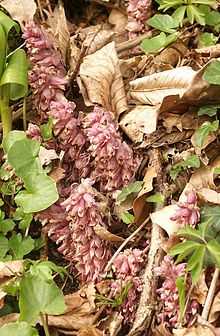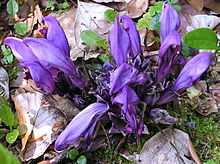Lathraea
| Toothwort | |
|---|---|
 | |
| Common toothwort (Lathraea squamaria) | |
| Scientific classification | |
| Kingdom: | Plantae |
| (unranked): | Angiosperms |
| (unranked): | Eudicots |
| (unranked): | Asterids |
| Order: | Lamiales |
| Family: | Orobanchaceae |
| Genus: | Lathraea |
| Species | |
|
Lathraea clandestina | |
Lathraea (toothwort) is a small genus of five to seven species of flowering plants, native to temperate Europe and Asia. They are parasitic plants on the roots of other plants, and are completely lacking chlorophyll. They are classified in the family Orobanchaceae.
The toothwort is a protocarnivorous plant. Most of the plant consists of a branched whitish underground stem closely covered with thick fleshy colourless leaves, which are bent over so as to hide the under surface; irregular cavities communicating with the exterior are formed in the thickness of the leaf. On the inner walls of these chambers are stalked hairs, which when stimulated by the touch of an insect send out delicate filaments by means of which the insect is killed and digested.[1][2]


- Common toothwort (Lathraea squamaria) is parasitic on the roots of hazel and alder, occasionally on beech, in shady places such as hedge sides. Lathraea squamaria is widespread in Europe.
- Purple toothwort (Lathraea clandestina) grows on the roots of alder, poplar and willow. It differs in the dark purple flowers being produced one on each stem. Purple toothwort grows in Middle and South Europe: Western Belgium, Western and Central France and Northern Spain, and locally in Central Italy.[3] Elsewhere, especially in England, the plant is locally acclimated in parks and old gardens.
- Rhodope toothwort (Lathraea rhodopaea) is common in the Rhodope Mountains and Rila mountain range in southeastern Europe.
In Pavel Ivanovich Melnikov's "In the Forests" a Russian wise woman (znakharka) calls this plant Peter's Cross and says it protects against devils but only if collected with a prayer to God.
References

Notes
- ↑ Francis Ernest Lloyd, The Carnivorous Plants, The Chronica Botanica Company, Waltham, Mass., 1942 - ISBN B0000EGY6B
- ↑ Encyclopaedia Britannica - Toothwort
- ↑ GRIN. Lathraea clandestina
External links
![]() Chisholm, Hugh, ed. (1911). "Toothwort". Encyclopædia Britannica (11th ed.). Cambridge University Press
Chisholm, Hugh, ed. (1911). "Toothwort". Encyclopædia Britannica (11th ed.). Cambridge University Press
| ||||||||||||||